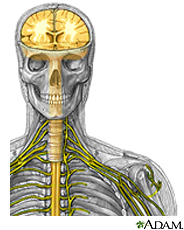 |
 |
 |
Other Health Topics:

-
Related Topics
-
Go Local
- Services and providers for Meningitis in the U.S.
-
National Institutes of Health
- The primary NIH organization for research on Meningitis is the National Institute of Neurological Disorders and Stroke
Languages
- Armenian (Հայերեն)
- Bosnian (Bosanski)
- Chinese - Traditional (繁體中文)
- Farsi (فارسی)
- French (français)
- Haitian Creole (Kreyol)
- Hindi (हिन्दी)
- Hmong (Hmoob)
- Italian (italiano)
- Japanese (日本語)
- Khmer (Khmer)
- Korean (한국어)
- Laotian (Lao)
- Panjabi (ਪੰਜਾਬੀ)
- Portuguese (português)
- Romanian (Română)
- Russian (Русский)
- Samoan (Gagana Samoa)
- Somali (af Soomaali)
- Spanish (español)
- Tagalog (Tagalog)
- Thai (ภาษาไทย)
- Turkish (Türkçe)
- Ukrainian (Українська)
- Vietnamese (Tiếng Việt)
Meningitis is inflammation of the thin tissue that surrounds the brain and spinal cord, called the meninges. There are several types of meningitis. The most common is viral meningitis, which you get when a virus enters the body through the nose or mouth and travels to the brain. Bacterial meningitis is rare, but can be deadly. It usually starts with bacteria that cause a cold-like infection. It can block blood vessels in the brain and lead to stroke and brain damage. It can also harm other organs.
Anyone can get meningitis, but it is more common in people whose bodies have trouble fighting infections. Meningitis can progress rapidly. You should seek medical care quickly if you have
- A sudden fever
- A severe headache
- A stiff neck
Early treatment can help prevent serious problems, including death. Vaccines can prevent some of the bacterial infections that cause meningitis. Parents of adolescents and students living in college dorms should talk to a doctor about the vaccination.
National Institute of Neurological Disorders and Stroke
-
Meningitis
 (Patient Education Institute) - Requires Flash Player
(Patient Education Institute) - Requires Flash Player
Also available in Spanish
-
Meningitis and Encephalitis
 (National Institute of Neurological Disorders and Stroke)
(National Institute of Neurological Disorders and Stroke)
Also available in Spanish
- Meningococcal Disease(Centers for Disease Control and Prevention)
| Basics | Learn More | Multimedia & Cool Tools |
|---|---|---|
| Research | Reference Shelf | For You |
-
Overviews
-
JAMA Patient Page: Meningitis(American Medical Association)
Also available in Spanish
- Meningitis(Mayo Foundation for Medical Education and Research)
-
Meningitis and Encephalitis
 (National Institute of Neurological Disorders and Stroke) - Short Summary
(National Institute of Neurological Disorders and Stroke) - Short Summary
-
JAMA Patient Page: Meningitis(American Medical Association)
-
Diagnosis/Symptoms
- Blood Culture(American Association for Clinical Chemistry)
-
JAMA Patient Page: Lumbar Puncture(American Medical Association)
Also available in Spanish
- Lumbar Puncture (Spinal Tap)(Nemours Foundation)
- Rapid Test Detects Viral Meningitis(Food and Drug Administration)
-
Prevention/Screening
- Meningitis Vaccine: Do Infants Need It?(Mayo Foundation for Medical Education and Research)
- Meningococcal Vaccine(Centers for Disease Control and Prevention) - Links to PDF
- Meningococcal Vaccines: Protecting You from Bacterial Meningitis(Centers for Disease Control and Prevention)
-
Pneumococcal Conjugate Vaccine(Centers for Disease Control and Prevention) - Links to PDF
Also available in Spanish
-
Pneumococcal Polysaccharide Vaccine (PPV23)(Centers for Disease Control and Prevention) - Links to PDF
Also available in Spanish
- Use of Meningitis Vaccine in Persons with Cochlear Implants(Centers for Disease Control and Prevention)
-
Specific Conditions
- Acute Bacterial Meningitis(Merck & Co., Inc.)
-
Arachnoiditis
 (National Institute of Neurological Disorders and Stroke) - Short Summary
(National Institute of Neurological Disorders and Stroke) - Short Summary
- Chronic Meningitis(Merck & Co., Inc.)
-
Cryptococcal Meningitis(New Mexico AIDS Education and Training Center)
Also available in Spanish
- Lymphocytic Choriomeningitis(Centers for Disease Control and Prevention)
- Viral (Aseptic) Meningitis(Centers for Disease Control and Prevention)
-
Related Issues
- Meningococcal Disease: Health Information for International Travel(Centers for Disease Control and Prevention)
-
Tutorials
-
Meningitis(Patient Education Institute) - Requires Flash Player
Also available in Spanish
-
Meningitis(Patient Education Institute) - Requires Flash Player
-
Clinical Trials
-
ClinicalTrials.gov: Arachnoiditis
 (National Institutes of Health)
(National Institutes of Health)
-
ClinicalTrials.gov: Meningitis
 (National Institutes of Health)
(National Institutes of Health)
-
ClinicalTrials.gov: Arachnoiditis
-
Journal Articles
References and abstracts from MEDLINE/PubMed (National Library of Medicine)
- Article: Epidemiology, etiology, pathogenesis, and diagnosis of recurrent bacterial meningitis.
- Article: EFNS guideline on the management of community-acquired bacterial meningitis: report...
- Article: Neoplastic meningitis.
- Meningitis -- see more articles
- Medical Encyclopedia Return to top
-
Organizations
- National Center for Zoonotic, Vector-Borne, and Enteric Diseases, Division of Foodborne, Bacterial and Mycotic Diseases(Centers for Disease Control and Prevention)
-
National Institute of Allergy and Infectious Diseases

-
National Institute of Neurological Disorders and Stroke

Also available in Spanish
-
Children
- Advice for Patients with Cochlear Implants: New Information on Meningitis Risk(Center for Devices and Radiological Health)
- Meningitis(Nemours Foundation)
-
Meningitis(Nemours Foundation)
Also available in Spanish
-
Teenagers
- Meningitis(Nemours Foundation)
- Meningococcal Vaccine: A Guide for Teens(Children's Hospital Boston)
| Home | Health Topics | Drugs & Supplements | Encyclopedia | Dictionary | News | Directories | Other Resources | |
| Disclaimers | Copyright | Privacy | Accessibility | Quality Guidelines U.S. National Library of Medicine, 8600 Rockville Pike, Bethesda, MD 20894 National Institutes of Health | Department of Health & Human Services |
Date last updated: 30 July 2008 Topic last reviewed: 25 March 2008 |






